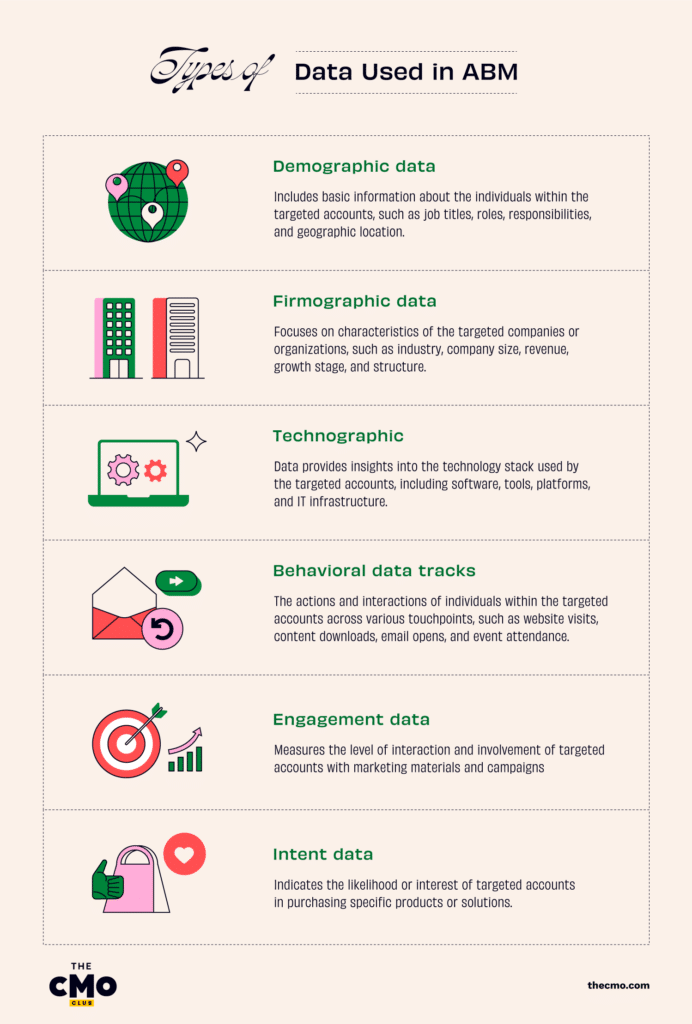Think of account-based marketing analytics as the compass guiding you towards ABM success. In order to target the right accounts and create content that speaks to their distinct pain points, you’ll need data—and lots of it.
Account-based marketing (ABM) is a popular B2B marketing strategy that targets individual accounts with highly-personalized campaigns. In ABM, success hinges entirely on your marketing team’s ability to optimize data collection and analysis, so here I’ll share how data pulled from marketing analytics software can fuel your ABM efforts, plus the best practices to monitor, collect and process it.
What Is Account-Based Marketing (ABM)?
Account-based marketing targets specific accounts that meet your ideal customer profile and are likely to generate significant ROI for your business.
Personalization is central to an account-based marketing strategy, as each step of the buyer’s journey is tailored to high-value accounts, including all messaging, content, and outreach efforts. This is unlike traditional marketing and lead generation, in which your marketing campaigns focus on a broader market of prospects.
Due to the emphasis on personalized campaigns, sales and marketing alignment must exist for account-based marketing tactics to work. When this alignment is achieved, 30% of marketers using ABM report a 21% increase to their ROI, according to a study by SiriusDecisions.
What Are Account-Based Marketing Analytics?
Account-based marketing analytics track data from different sources like marketing CRM software, social media, and website analytics. This data is necessary to define multiple aspects of your ABM strategy, such as target account lists, marketing campaigns and personalized touch points throughout the customer journey.
The Importance Of Data In ABM
An ABM approach without personalization is like a puzzle with missing pieces—you have the components, but you don’t have the complete picture. Account-based marketing personalization starts with understanding your target accounts, which requires In-depth data on their preferences, behavior and needs. This data is invaluable both for campaigns and future sales outreach.
You need to track and analyze every interaction these accounts have with your brand. That means monitoring website visits, email opens, content downloads, social media engagement, and any other touchpoints.
Jon Morgan, CEO & Editor-in-Chief of Venture Smarter
Types Of Data Used In ABM

Now that we understand why having lots of data is crucial for ABM, let's explore the different forms of data you need:
- Demographic data includes basic information about the individuals within the targeted accounts, such as job titles, roles, responsibilities, and geographic location. Using demographic segmentation helps tailor messaging and content to resonate with specific audience segments.
- Firmographic data focuses on characteristics of the targeted companies or organizations, such as industry, company size, revenue, growth stage, and structure. This information helps identify accounts that align with the ideal customer profile and prioritize high-value targets.
- Technographic data provides insights into the technology stack used by the targeted accounts, including different software, tools, platforms, and IT infrastructure. Understanding the technological environment of the accounts enables marketers to tailor solutions and offerings that integrate seamlessly with their existing systems.
- Behavioral data tracks the actions and interactions of individuals within the targeted accounts across various touchpoints, such as website visits, content downloads, email opens, and event attendance.
- Engagement data measures the level of interaction and involvement of targeted accounts with marketing materials and campaigns. This includes metrics such as click-through rates, time spent on content, social media interactions, and webinar attendance.
- Intent data indicates the likelihood or interest of targeted accounts in purchasing specific products or solutions. This data is derived from signals such as online search behavior, content consumption patterns, and interactions with competitor websites.
With this data at your disposal, your next step is to harness the power of this information for targeted campaigns and meaningful engagement.
How To Use ABM Analytics
You’ve collected your data, and now it’s time to put it to work. There are many ways to leverage analytics for your ABM initiatives, including predicting customer behavior, qualifying or scoring leads as MQLs vs SQLs, and mapping customer touch points.
Predictive Analytics
Predictive analytics use historical data, machine learning, and statistical algorithms to identify conversion-ready accounts. B2B sales cycles can be long, complex, and involve various decision-makers. anticipating your target accounts' needs and behavior is essential. In fact, The Predictive Intelligence Benchmark Report reveals a 22.66% average lift in conversion rate for sessions influenced by predictive intelligence.
Examples of predictive analytics include:
- Purchase history
- Browsing behavior
- Demographic information
- Past sales data
Account and Lead Scoring
Lead scoring ranks and evaluates leads based on their likeliness to convert into customers. Classifying leads as either Marketing Qualified Leads (MQLs) or Sales Qualified Leads (SQLs) supports marketing alignment with sales.
To score your leads, use marketing CRM software, like Hubspot or Salesforce, to assign numerical ranks based on criteria such as demographics, firmographics, engagement level, and behavior.
MQLs demonstrate interest and engagement with marketing efforts, while SQLs have been vetted and deemed ready for direct sales engagement. By prioritizing SQLs, ABM campaigns can yield higher conversion rates and maximize ROI.
Examples of data used for lead scoring include:
- Company size, industry and location
- Organization revenue
- Engagement rates
- Webinar attendance
- Demo requests or sales engagement
- Email opens or resource downloads
- Budget and buying authority
Data Enrichment
Data enrichment enhances your customer data and personas by adding or updating information as it becomes available. Keeping your databases current provides deeper insights into your target audience, improving content marketing, sales outreach, and your overall ABM strategy.
Examples of data enrichment include:
- Improving firmographic data such as company revenue, budget, and industry classification
- Enriching customer profiles with technographic data to identify technology preferences and usage patterns
Contact Mapping Key Accounts
Contact mapping is used to identify and understand the relationships and connections within target accounts. Identifying key stakeholders within each organization and understanding their role in the buying process improves your ability to tailor messaging and personalize ABM content to address specific pain points and interests.
Data points that can help with mapping include:
- Job titles
- Departmental responsibilities
- Organizational hierarchies
Data Validation
Data validation ensures accuracy, completeness, and reliability of data collected or stored within a database or system. For ABM programs in particular, it’s important to periodically review data and to correct errors, inconsistencies, or inaccuracies, such as duplicate entries, missing values, or incorrect formatting. Reliable data is necessary for effective ABM campaigns, and with better data comes a higher return on investment and revenue growth.
Measuring Campaign Success
Keeping an eye on key performance indicators (KPIs), such as conversion rates, pipeline velocity, and customer acquisition costs, is necessary to improve and validate the ROI of your ABM campaigns. Account-based marketing software can streamline this process by automatically tracking and analyzing these metrics. Through these marketing automations you can receive real-time insights into audience engagement, content performance, and overall campaign impact.
Campaign data and ABM metrics used to monitor success include:
- Conversion rates
- Pipeline velocity
- Customer acquisition costs (CAC)
- Account engagement metrics
- Click-through rates (CTR)
- Time spent on page
- Bounce rates
- Revenue generated
- Customer lifetime value (CLV)
Benefits Of Account-Based Marketing Analytics
Improved ABM Campaign Performance
ABM analytics inform your campaign strategy and direction, allowing you to measure and track KPIs such as conversion rates, engagement metrics, and return on investment.
Campaign analytics shine a light on what’s working in your strategy, and what needs improvement. By analyzing this data, you can refine your targeting strategies, personalize your messaging, and allocate resources more efficiently to maximize campaign performance.
Increased Target Account Engagement
High-value accounts deserve high-quality engagement, and ABM analytics give you the information needed to provide an outstanding customer experience. Not only that, but by analyzing target account data you can be sure you’re prioritizing the best leads.
With data and insights, you can tailor your outreach and messaging to the specific needs and preferences of your target audience, which increases ABM engagement and builds stronger relationships with key decision-makers and stakeholders. Track the progress and interactions of leads and contacts across accounts, supporting effective lead nurturing and demand generation efforts.
Expanded Lead Generation and Deal Sizes
ABM analytics help you identify new opportunities and expand your reach within target accounts by uncovering previously undiscovered leads and contacts. By analyzing data on account engagement and behavior, you can identify cross-selling and upselling opportunities, as well as potential areas for expansion or growth within existing accounts.
Track the impact of your campaigns on lead generation and deal sizes, allowing you to measure the ROI of your efforts and justify investment in ABM initiatives. This is particularly beneficial for B2B companies relying on inbound marketing strategies.
Join For More Account-Based Marketing Insights
Just as your team looks to you for direction, ABM analytics can steer your strategy toward success. However, it's essential to have the right processes in place to effectively analyze and monitor them, ensuring you stay on course.
By harnessing various types of data—demographic, firmographic, technographic, behavioral, engagement, and intent—you can tailor your messaging, identify high-value targets, and engage with your audience better.
Looking for more guidance on ABM? Stay updated on the latest insights and trends in account-based marketing by subscribing to The CMO newsletter!


